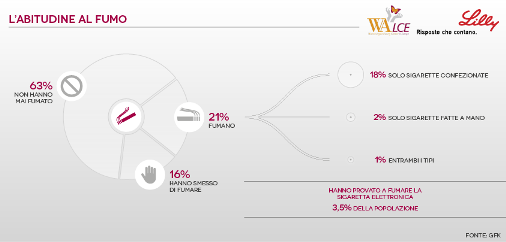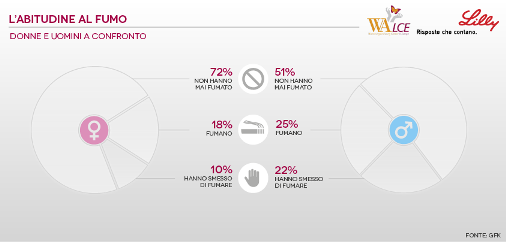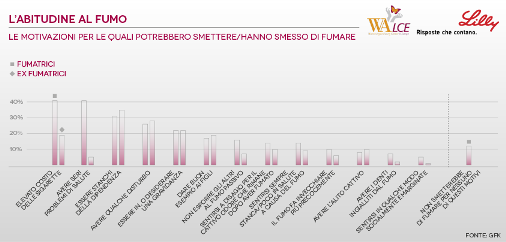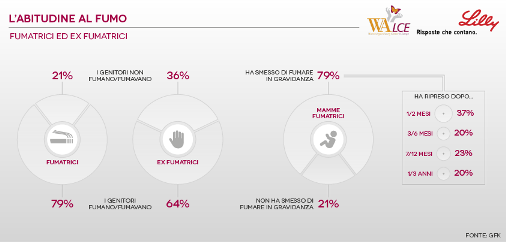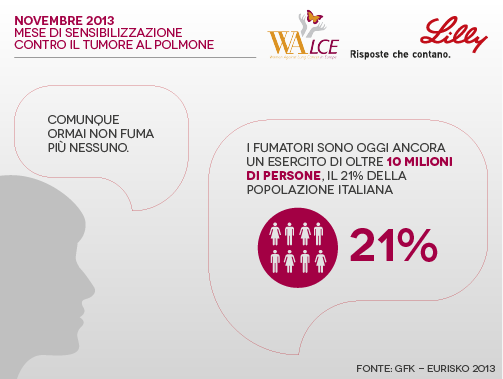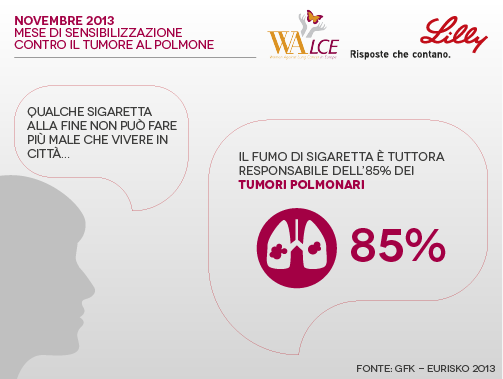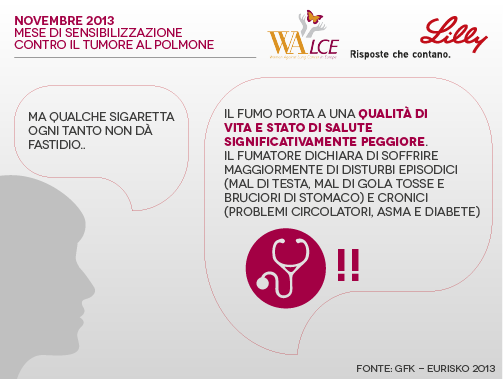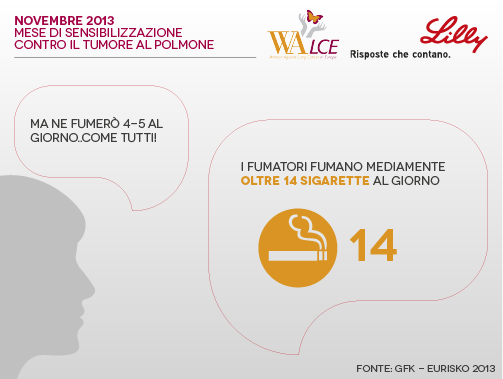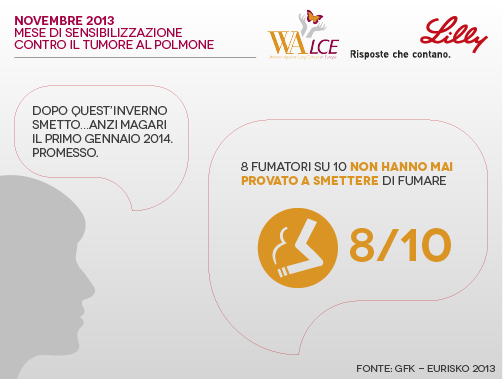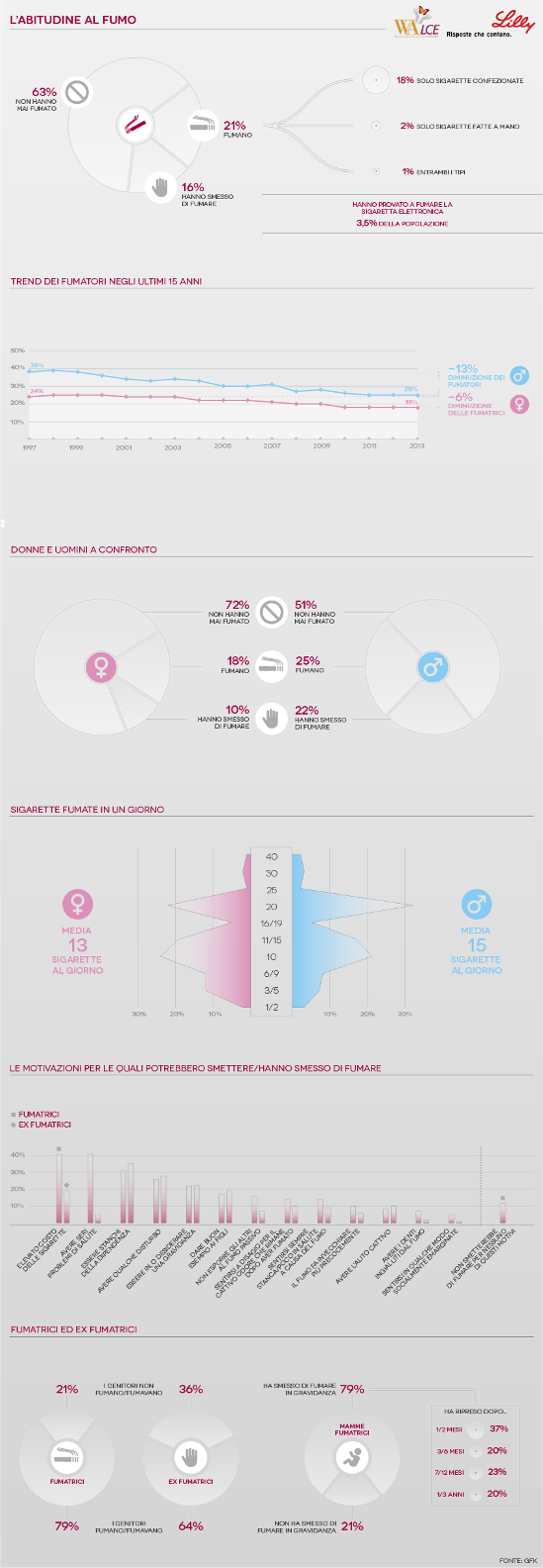Smetti di Fumare
Smetti di Fumare è un video motivazionale che ha visto la partecipazione di
Elena Barolo, Sergio Muniz e Igor Cassina
con un obiettivo importante: abbandonare per sempre le sigarette.
Incontro per la Stampa “Smetti di Fumare“
Mercoledì 6 novembre 2013 – Milano, Circolo della Stampa
Con la partecipazione di Elena Barolo e Igor Cassina
Infografiche e Dati
Comunicato stampa
FUMA ANCORA UN ITALIANO SU 5: E LE DONNE FATICANO A SMETTERE
Un vizio che pesa non solo sulla salute ma anche sulle tasche: quasi 30 milioni di € in fumo al giorno, 11 miliardi all’anno
Nonostante un calo di fumatori in Italia registrato negli ultimi 15 anni (dal 31% del 1998 al 21% nel 2013), i fumatori sono ancora un esercito di oltre 10 milioni di persone, resistenti ad abbandonare l’abitudine al fumo. E le donne fumatrici crescono in percentuale rispetto ai fumatori uomini e diminuiscono con una fatica ‘doppia’ rispetto agli uomini 6% contro il 13%. Lo rivela una fotografia di Gfk Eurisko voluta da WALCE grazie alla collaborazione di Lilly Italia in occasione del mese di novembre che è in tutto il mondo il mese di sensibilizzazione per il tumore al polmone (LCAM – Lung Cancer Awareness Month). ‘Smetti di fumare’ è il grido lanciato dall’Associazione contro un vizio che è anche l’unico fattore di rischio accertato per il cancro al polmone un killer che uccide 160.000 persone ogni anno. ’Smetti di fumare’ è anche il titolo del video che ha visto la partecipazione di Elena Barolo, Sergio Muniz e Igor Cassina con un semplice obiettivo: abbandonare per sempre le sigarette.
Milano 5 novembre 2013 – Il vizio del fumo continua a mietere consensi e vittime. E’ ancora un’insana abitudine per 10,2 milioni di italiani nonostante sia l’unico fattore di rischio certo per lo sviluppo del cancro al polmone, responsabile di quasi il 30% dei decessi fra le forme tumorali conosciute, in grado di uccidere quindi più del cancro al colon, al seno e alla prostata messi insieme.
Per accendere i riflettori sul fumo e le sue conseguenze, il mese di novembre è stato dedicato, infatti, in tutto il mondo alla sensibilizzazione sul tumore al polmone, e riconosciuto come LCAM (Lung cancer awareness month); in questa occasione Walce Italia (Women against lung cancer) grazie al contributo di Lilly Italia, ha commissionato una nuova indagine di Gfk Eurisko sulle abitudini al fumo degli italiani, svolta utilizzando un patrimonio di dati di 15 anni e con un focus particolare sulle donne e il fumo.
Secondo l’indagine che ha utilizzato dati di 9560 individui dai 18 anni in su e rappresentativi della popolazione italiana, è calato il numero di fumatori in Italia negli ultimi 15 anni (dal 31% del 1998 al 21% nel 2013), ma i fumatori sono oggi ancora un esercito di oltre 10 milioni di persone, che fumano mediamente oltre 14 sigarette al giorno e resistenti a smettere (8 su 10 non ha mai provato a farlo). Calcolando un prezzo medio a pacchetto di 4 € stiamo parlando di quasi 30 milioni di € al giorno che gli italiani bruciano ogni giorno, 11 miliardi all’anno. Senza contare i costi per la salute, per la sanità pubblica, per la qualità di vita loro e di chi ne ha conseguenze ‘passive’.
“Un vizio dalle conseguenze drammatiche non solo sul livello generale di benessere e qualità di vita dei fumatori, ma anche sui numeri del cancro considerato che il fumo di sigaretta è tuttora responsabile dell’85% dei tumori polmonari” ha dichiarato Silvia Novello – Pneumo-oncologa presso il Dipartimento di Oncologia, Università di Torino, AOU San Luigi Orbassano (TO) e Presidente WALCE onlus (Women Against Lung Cancer in Europe).
“Il carcinoma polmonare ha anche in Italia la fama di Big Killer con un’ incidenza in costante aumento e il numero di nuovi casi per anno che è intorno ai 35-40.000/100.000 abitanti, con un tasso di mortalità di 81/100.000 nei maschi e 12/100.000 nelle donne. Alcuni buoni segnali però vengono dall’innovazione terapeutica che sta portando sempre migliori risultati in termini di sopravvivenza e qualità di vita, in particolare grazie ai progressi in campo diagnostico e terapeutico facendo riferimento alla personalizzazione terapeutica e all’introduzione di nuove molecole e/o nuovi approcci terapeutici. Tutto ciò ha consentito, per la malattia in stadio avanzato, di superare quella sopravvivenza media di un anno che per lungo periodo di tempo sembrava una barriera insormontabile per ricercatori e clinici. “
“E proprio sulle donne – continua la Novello – sembra necessaria una specifica attività di sensibilizzazione considerato che, dai dati a disposizione oggi, sembra che la percentuale di donne fumatrici sia in crescita rispetto ai maschi, e che facciano fatica a smettere anche in momenti delicati come la gravidanza. Non è un caso che il tumore al polmone, prima esclusivo appannaggio del genere maschile sia ora una dei tumori che spaventa o meglio, dovrebbero spaventare, molto anche le donne”
Le donne e il fumo
Secondo l’analisi svolta per l’occasione da Gfk Eurisko, cresce, infatti, la percentuale di donne fra i fumatori (a fronte di una diminuzione degli uomini). Sono oggi 4,5 milioni le donne che fumano, concentrate in una fascia di età centrale (fra i 25 e 54 anni). Nel corso di quindici anni la percentuale di fumatrici è scesa di 6 punti percentuale rispetto ai 13 punti dei fumatori maschi. Sono meno casalinghe rispetto alle donne non fumatrici, in metà dei casi hanno figli, 1 su 4 ha figli minorenni. Nella maggior parte dei casi hanno genitori che fumavano, e tutte le donne fumatrici prima di aver figli hanno ricominciato, mediamente entro 8 mesi dopo il parto (da segnalare come quasi la metà ha ricominciato immediatamente dopo, entro i primi 2 mesi dal parto). Pensando ai motivi che potrebbero spingerle a smettere, al primo posto il costo (segno del forte impatto della crisi economica) e seri problemi di salute: importante e, in crescita rispetto al passato, anche la sensibilità al fumo passivo e lo stigma sociale. Ma i motivi che le hanno realmente spinte a smettere si devono ricercare nell’esperienza dei problemi quotidiani e nell’attenzione a sé e agli altri (piccoli disturbi, dipendenza , essere un modello positivo per i propri figli).
“Smetti di Fumare”
“Non c’è metodo alternativo” afferma ancora con decisione la Novello. “L’unica vera soluzione, sicuramente non semplice e con implicazioni molto diverse da una persona all’altra, è abbandonare completamente il vizio, liberandosene anche psicologicamente. Per questa ragione – continua la dott.ssa Novello – abbiamo realizzato un video motivazionale dal titolo molto semplice e diretto, ‘Smetti di Fumare’ che farà parte della nostra Campagna di sensibilizzazione a livello nazionale Questo video ha visto la partecipazione di tre testimonial d’eccezione che si sono uniti a noi in questo grido di allarme: Elena Barolo (conduttrice, attrice e blogger), Sergio Muniz (modello e attore) e Igor Cassina (campione olimpico di ginnastica artistica). Nelle parole dei protagonisti consigli preziosi per lasciarsi il vizio del fumo alle spalle. Il video è stato realizzato con il contributo incondizionato di Roche.
Identikit del fumatore italiano e come è cambiato rispetto al passato?
6 su 10 sono uomini, giovani-maturi (l’80% ha meno di 54 anni), concentrati nella fascia della popolazione con un profilo socio-culturale più basso rispetto ai non fumatori, anche se un terzo un titolo di scuola superiore e il 10% una laurea. 4 su 10 vivono con i figli , nella metà dei casi minorenni, 1 su 2 fuma anche in casa. Rispetto a 15 anni fa cresce , in generale, il livello socioculturale (in linea con il trend generale della popolazione) e cresce la percentuale di donne fumatrici. Nonostante ciò si osserva un fenomeno positivo: diminuiscono i fumatori più giovani, segno che l’influenza sociale e le normative hanno favorito un minor accesso dei giovani al fumo.
Dal punto di vista psicologico il fumatore si descrive come una persona che ama le novità e il rischio, più nervoso ed impulsivo e meno ordinato rispetto a chi non fuma. Nei confronti della saluta mostra maggiore fatalismo e minore attenzione preventiva.
Quale impatto del fumo sulla qualità di vita e sulla salute?
Confrontando i fumatori con i non fumatori nelle stesse fasce di età emerge in modo significativo come il fumo sia significativamente correlato alla qualità di vita, alla percezione del proprio stato di benessere (fisico e mentale) e allo stato effettivo di salute. Infatti, chi fuma ha una percezione più critica su tutti gli indicatori di qualità di vita (reddito, istruzione, lavoro, abitazione, affetti e salute), valuta in modo più negativo il suo stato di salute (fisico e mentale), dichiara di soffrire maggiormente di disturbi episodici (mal di testa, mal di gola tosse e bruciori di stomaco) e cronici (problemi circolatori, asma e diabete). Insomma, il fumo è correlato ad una qualità di vita e stato di salute significativamente peggiore rispetto alle persone non fumatrici.
“Stop Smoking”: the video (ENGL SUB)
A motivational video titled very simple and straightforward.
This video includes the participation of three testimonials: Elena Barolo (presenter, actress and blogger), Sergio Muniz (model and actor) and Igor Cassina (Olympic champion in artistic gymnastics –Golden medal at Athens 2004).
1 OUT OF 5 ITALIAN IS STILL A SMOKER AND WOMEN FIND IT HARDER THAN MEN STOP SMOKING
A bad habit that weighs not only on the health but also on the pockets: almost € 30 million up in smoke per day, 11 billion per year.
Despite a decline in smoking in Italy over the last 15 years (from 31% in 1998 to 21% in 2013), smokers are still over 10 million people, resistant to give up the smoking habit. Women who smoke are growing more than men. This was revealed by Gfk Eurisko survey commissione by WALCE with the support of Lilly during November, the Lung Cancer Awareness Month – LCAM.
‘Stop Smoking’ is asked by the Association against a vice that is also the only recognized risk factor for lung cancer that kills 160,000 people each year. ‘Stop Smoking’ is also the title of the video realized by WALCE with three well-known Italian people Elena Barolo, Sergio Muniz and Igor Cassina with the goal:to stimulate people to quit the cigarettes.
Milan, November 5, 2013 – The habit of smoking continues to claim victims and consents. It’s still an unhealthy habit for 10.2 million Italians despite being the only definite risk factor for the development of lung cancer, responsible for almost 30% of deaths among the cancers known, able to kill more people than colon, breast and prostate cancer combined.
To turn the spotlight on smoking and its consequences , the month of November was dedicated all over the world to raise awareness about this disease and on this occasion WALCE (Women against lung cancer) with the support of Lilly Italy, commissioned a new survey to Gfk Eurisko on Italian smoking habits, carried out using a 15 year data and with a particular focus on women and smoking.
According to the survey which used data from 9560 individuals aged 18 years and representative of the Italian population, the number of smokers has declined in Italy in the last 15 years (from 31 % in 1998 to 21% in 2013), but smokers are still over 10 million people and they smoke more than 14 cigarettes per day and are resistant to quit (8 out of 10 have never tried to do it). Assuming an average package price about 4€ we are talking about almost 30 million€ spent each day and 11 billion per year. And other costs include health, public health, quality of life costs and the consequences for those who receive the effects of passive smoke.
“An habit which has dramatic consequences not only on the general level of well-being and smoker quality of life, but also on the numbers of cancer patients considering that smoking is still responsible for 85% of lung cancers,” said Silvia Novello – Pneumo – oncologist at the Department of Oncology, University of Torino, AOU San Luigi Orbassano (TO) and President of WALCE non-profit organization.
“Lung cancer also in Italy has the reputation of Big Killer with a steady increasing incidence and the number of new cases per year is around 35-40.000/100.000 inhabitants, with a mortality rate of 81/100.000 in males and 12/100.000 in women. However therapeutic innovations give good signs, because they are bringing more and better results in terms of survival and quality of life, particularly due to the advances in diagnostic and therapeutic referring to the treatment personalization and the introduction of new molecules and/or therapeutic approaches. This allowed to the advanced stage disease, to overcome the median survival of a year that for a long period seemed to be an insurmountable barrier for researchers and clinicians .”
“And exactly women – continues Dr Novello – seem to require a more specific awareness activity considering that, from data available nowadays, it seems that the proportion of women who smoke is increasing compared to males, and they find it harder to stop even in particular moments such as pregnancy. It is not a coincidence that the lung cancer, earlier the exclusive prerogative of the male gender is now one of the cancers that scares or better said, should frighten even women”.
Women and smoking
According to the analysis carried out for the occasion by Gfk Eurisko, the percentage of women among smokers is increasing (compared with a decrease of men). Currently there are 4.5 million women who smoke, concentrated in a band of middle age (between 25 and 54 years). In the last fifteen years, the percentage of smokers has dropped by 6 percentage points comparing the 13 points of male smokers. In half cases they have children and 1 out 4 women has minor children. In the most of cases their parents were used to smoke and all the women who smoke before having children have started again, on average, within 8 months after giving birth. Thinking about the reasons for quitting, the first place is for the cost (sign of the strong impact of the economic crisis) and serious health problems: important and growing more than in the past, also the sensitivity to passive smoking and the social stigma. But the reasons that have really pushed to quit must be sought in the experience of everyday problems and attention to themselves and to others (small disturbances, addiction, being a positive model for their children).
“Stop Smoking”
“There are no alternatives” Dr Novello confirms again. “The only real solution, certainly not simple, with very different implications from one person to another, is to completely quit this habit. For this reason – she continues – we realized a motivational video titled very simple and straightforward, ‘Stop Smoking’ which will be part of our awareness campaign at national level. This video includes the participation of three testimonials: Elena Barolo (presenter, actress and blogger), Sergio Muniz (model and actor) and Igor Cassina (Olympic champion in artistic gymnastics –Golden medal at Athens 2004). The video was produced thanks to an unrestricted grant of Roche.
Italian identikit of the smoker and how has it changed compared to the past?
6 out of 10 are young – mature (80 % are under 54 years old) men, concentrated in the population segment with a socio-cultural profile lower than non-smokers, although a third of them went to the college and 10% has a degree. 4 out of 10 live with their children, half of them are minors and 1 out of 2 smokes also in the house. Compared to 15 years ago the socio-cultural level is growing (in line with the general trend of the population) and the percentage of female smokers is growing too. Nevertheless we observe a positive phenomenon: younger smokers are decreasing, as a sign that the social influence and regulations favored a lower access of young people to smoking habit. From the psychological point of view someone who smokes describes himself as a person who loves novelty and risk, more nervous and impulsive and less orderly than those who do not smoke. Towards his health he shows a greater fatalism and less preventive care.
What is the smoking impact on quality of life and health?
Comparing smokers with non-smokers in the same age group we can notice that smoking is strictly related to the quality of life, the perception of one’s state of well-being (physical and mental) and the actual state of health. Anyone who smokes has a more critical perception of all the indicators of quality of life (income, education, employment, housing, health and suffering), evaluates in a more negative way his health state (physical and mental), declares to suffer more for episodic disorders (headache, sore throat, cough and heartburn) and chronic ones (circulatory problems, asthma and diabetes).
Smoking is related to a quality of life and health status significantly worse for smokers than for non- smokers.














